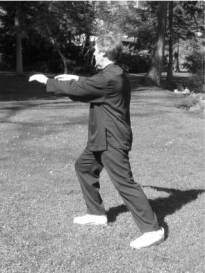Gilman Studio On-Line Lessons
Yang Style Long Form
Tai Chi Chuan
This Lessons Contains:
Movement # 6 – Push (An Jin)
Push seems to be the most obvious of the eight energies; after all, we all know how to push something. But An, even though it is translated as Push, is not the same thing. An means two hands pushing downward. If I were to push a car straight forward, that would be considered Peng, not An. If we want to push in Tai Chi, first we must pull to upset the root. It is this pull then push that makes An Jin look like magic as a large opponent gets thrown away. The study of Push Hands will help the student understand the difference between all these similar, yet different energies. In this application, my partner pushes in with two hands. I withdraw and apply An Jin, which uproots her. I then push her away. Always remember to follow partner’s incoming energy until you can softly neutralize it, and then attack back. Do not try and overcome force with force. An Jin is most powerfully delivered by pressing down into the front leg, similar to how a hydraulic jack works.

 Following the end of Press, there is very little change in the body. The arms unfold and extend to end up parallel to the ground, the same as in Commencement. Be sure to keep the elbows and shoulders drooped.
Following the end of Press, there is very little change in the body. The arms unfold and extend to end up parallel to the ground, the same as in Commencement. Be sure to keep the elbows and shoulders drooped.
In this application, Stephanie pushes in. My arms and hands relax and stick to her arms. I listen with my body to the strength and direction of her push.

 In this case, she is pushing equally with both hands, so I follow her incoming energy, and as she reaches the full extent of her ability to maintain a root, I apply An Jin and gently draw her out of the root. She is now falling forward. If she were to have pushed more with one hand, I would have turned in that direction, following her force, with the same result. Only through practice with many partners can the skill of Ting or listening is fully understood.
In this case, she is pushing equally with both hands, so I follow her incoming energy, and as she reaches the full extent of her ability to maintain a root, I apply An Jin and gently draw her out of the root. She is now falling forward. If she were to have pushed more with one hand, I would have turned in that direction, following her force, with the same result. Only through practice with many partners can the skill of Ting or listening is fully understood.
When withdrawing, move the body straight back into left foot sit stance. Do not lean; keep the back straight. Do not let the elbows get behind the body, which would allow partner’s energy to overcome you.

 The body shifts back into right foot bow stance. The two arms move with the body and rise up slightly to end up in the upper chest area. Do not lock the elbows; always keep the elbow droop.
The body shifts back into right foot bow stance. The two arms move with the body and rise up slightly to end up in the upper chest area. Do not lock the elbows; always keep the elbow droop.
It is important to realize that the push forward is being done with the legs, not the arms. The arms are only the connection between the energy of the legs and your partner. If you try to push a heavy object (no offence Stehpie), you will not get far. You must attach to the object with your hands, apply enough Peng to make a solid connection, and then push the earth away with your legs. This movement is also much more effective when the end of the push comes from the front leg.

